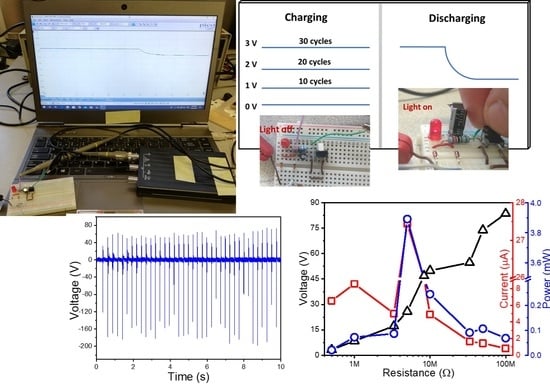Triboelectric Energy Harvesting Response of Different Polymer-Based Materials
Abstract
1. Introduction
2. Experimental
2.1. Materials
2.2. Sample Preparation
2.3. Triboelectric Measurements
3. Results and Discussion
3.1. Triboelectric Output
3.2. Energy Harvesting Application
4. Conclusions
Author Contributions
Funding
Acknowledgments
Conflicts of Interest
References
- Li, J.; Zhang, X.; Ali, S.; Khan, Z. Eco-innovation and energy productivity: New determinants of renewable energy consumption. J. Environ. Manag. 2020, 271, 111028. [Google Scholar] [CrossRef] [PubMed]
- Chen, C.; Pinar, M.; Stengos, T. Renewable energy consumption and economic growth nexus: Evidence from a threshold model. Energy Policy 2020, 139, 111295. [Google Scholar] [CrossRef]
- Chandrasekaran, S.; Bowen, C.; Roscow, J.; Zhang, Y.; Dang, D.K.; Kim, E.J.; Misra, R.D.K.; Deng, L.; Chung, J.S.; Hur, S.H. Micro-scale to nano-scale generators for energy harvesting: Self powered piezoelectric, triboelectric and hybrid devices. Phys. Rep. 2019, 792, 1–33. [Google Scholar] [CrossRef]
- Jiang, D.; Xu, M.; Dong, M.; Guo, F.; Liu, X.; Chen, G.; Wang, Z.L. Water-solid triboelectric nanogenerators: An alternative means for harvesting hydropower. Renew. Sustain. Energy Rev. 2019, 115, 109366. [Google Scholar] [CrossRef]
- Luo, J.; Wang, Z.L. Recent advances in triboelectric nanogenerator based self-charging power systems. Energy Storage Mater. 2019, 23, 617–628. [Google Scholar] [CrossRef]
- Nozariasbmarz, A.; Collins, H.; Dsouza, K.; Polash, M.H.; Hosseini, M.; Hyland, M.; Liu, J.; Malhotra, A.; Ortiz, F.M.; Mohaddes, F.; et al. Review of wearable thermoelectric energy harvesting: From body temperature to electronic systems. Appl. Energy 2020, 258, 114069. [Google Scholar] [CrossRef]
- Costa, P.; Nunes-Pereira, J.; Pereira, N.; Castro, N.; Gonçalves, S.; Lanceros-Mendez, S. Recent Progress on Piezoelectric, Pyroelectric, and Magnetoelectric Polymer-Based Energy-Harvesting Devices. Energy Technol. 2019, 7, 1800852. [Google Scholar] [CrossRef]
- Lu, Y.; O’Riordan, E.; Cottone, F.; Boisseau, S.; Galayko, D.; Blokhina, E.; Marty, F.; Basset, P. A batch-fabricated electret-biased wideband MEMS vibration energy harvester with frequency-up conversion behavior powering a UHF wireless sensor node. J. Micromech. Microeng. 2016, 26, 124004. [Google Scholar] [CrossRef]
- Chen, J.; Wang, Z.L. Reviving Vibration Energy Harvesting and Self-Powered Sensing by a Triboelectric Nanogenerator. Joule 2017, 1, 480–521. [Google Scholar] [CrossRef]
- Wang, S.; Lin, L.; Wang, Z.L. Triboelectric nanogenerators as self-powered active sensors. Nano Energy 2015, 11, 436–462. [Google Scholar] [CrossRef]
- Wang, Z.L. Triboelectric Nanogenerators as New Energy Technology for Self-Powered Systems and as Active Mechanical and Chemical Sensors. ACS Nano 2013, 7, 9533–9557. [Google Scholar] [CrossRef]
- Kim, D.W.; Lee, J.H.; Kim, J.K.; Jeong, U. Material aspects of triboelectric energy generation and sensors. NPG Asia Mater. 2020, 12, 6. [Google Scholar] [CrossRef]
- Wang, Z.L. On Maxwell’s displacement current for energy and sensors: The origin of nanogenerators. Mater. Today 2017, 20, 74–82. [Google Scholar] [CrossRef]
- Dharmasena, G.R.D.I.; Silva, S.R.P. Towards optimized triboelectric nanogenerators. Nano Energy 2019, 62, 530–549. [Google Scholar] [CrossRef]
- Saxon, D.J.; Luke, A.M.; Sajjad, H.; Tolman, W.B.; Reineke, T.M. Next-generation polymers: Isosorbide as a renewable alternative. Prog. Polym. Sci. 2020, 101, 101196. [Google Scholar] [CrossRef]
- Yoon, J.H.; Ryu, H.; Kim, S.-W. Sustainable powering triboelectric nanogenerators: Approaches and the path towards efficient use. Nano Energy 2018, 51, 270–285. [Google Scholar] [CrossRef]
- Wang, Z.L. Triboelectrification, in Triboelectric Nanogenerators; Springer International Publishing: Cham, Switzerland, 2016; pp. 1–19. [Google Scholar]
- Pan, S.; Zhang, Z. Fundamental theories and basic principles of triboelectric effect: A review. Friction 2019, 7, 2–17. [Google Scholar] [CrossRef]
- McCarty, S.L.; Whitesides, G.M. Electrostatic Charging Due to Separation of Ions at Interfaces: Contact Electrification of Ionic Electrets. Angew. Chem. Int. Ed. 2008, 47, 2188–2207. [Google Scholar] [CrossRef] [PubMed]
- Friedrich, K. Polymer composites for tribological applications. Adv. Ind. Eng. Polym. Res. 2018, 1, 3–39. [Google Scholar] [CrossRef]
- Lee, J.H.; Kim, J.; Kim, T.Y.; Al Hossain, M.S.; Kim, S.W.; Kim, J.H. All-in-one energy harvesting and storage devices. J. Mater. Chem. A 2016, 4, 7983–7999. [Google Scholar] [CrossRef]
- Wang, Z.L.; Lin, L.; Chen, J.; Niu, S.; Zi, Y. Triboelectric Nanogenerator: Vertical Contact-Separation Mode. In Triboelectric Nanogenerators; Wang, Z., Lin, L., Chen, J., Niu, S., Zi, Y., Eds.; Springer International Publishing: Cham, Switzerland, 2016; pp. 23–47. [Google Scholar]
- Marinho, T.; Costa, P.; Lizundia, E.; Costa, C.M.; Corona-Galván, S.; Lanceros-Méndez, S. Ceramic nanoparticles and carbon nanotubes reinforced thermoplastic materials for piezocapacitive sensing applications. Compos. Sci. Technol. 2019, 183, 107804. [Google Scholar] [CrossRef]
- Martins, P.; Lopes, A.C.; Lanceros-Mendez, S. Electroactive phases of poly(vinylidene fluoride): Determination, processing and applications. Prog. Polym. Sci. 2014, 39, 683–706. [Google Scholar] [CrossRef]
- Ribeiro, C.; Costa, C.M.; Correia, D.M.; Nunes-Pereira, J.; Oliveira, J.; Martins, P.; Goncalves, R.; Cardoso, V.F.; Lanceros-Mendez, S. Electroactive poly(vinylidene fluoride)-based structures for advanced applications. Nat. Protoc. 2018, 13, 681–704. [Google Scholar] [CrossRef] [PubMed]
- Costa, P.; Silva, J.; Mendez, S.L. Strong increase of the dielectric response of carbon nanotube/poly(vinylidene fluoride) composites induced by carbon nanotube type and pre-treatment. Compos. Part B Eng. 2016, 93, 310–316. [Google Scholar] [CrossRef]
- Wang, Z.L. Triboelectric Nanogenerators, 1st ed.; Springer: New York, NY, USA, 2016; pp. 1–517. [Google Scholar]
- Diaz, F.A.; Felix-Navarro, R.M. A semi-quantitative tribo-electric series for polymeric materials: The influence of chemical structure and properties. J. Electrost. 2004, 62, 277–290. [Google Scholar] [CrossRef]
- Lapčinskis, L.; Mālnieks, K.; Linarts, A.; Blūms, J.; Šmits, K.; Järvekülg, M.; Knite, M.; Šutka, A. Hybrid Tribo-Piezo-Electric Nanogenerator with Unprecedented Performance Based on Ferroelectric Composite Contacting Layers. ACS Appl. Energy Mater. 2019, 2, 4027–4032. [Google Scholar] [CrossRef]
- Zhang, J.H.; Li, Y.; Du, J.; Hao, X.; Huang, H. A high-power wearable triboelectric nanogenerator prepared from self-assembled electrospun poly(vinylidene fluoride) fibers with a heart-like structure. J. Mater. Chem. A 2019, 7, 11724–11733. [Google Scholar] [CrossRef]
- Singh, H.H.; Khare, N. Flexible ZnO-PVDF/PTFE based piezo-tribo hybrid nanogenerator. Nano Energy 2018, 51, 216–222. [Google Scholar] [CrossRef]
- Cheng, X.; Tang, W.; Song, Y.; Chen, H.; Zhang, H.; Wang, Z.L. Power management and effective energy storage of pulsed output from triboelectric nanogenerator. Nano Energy 2019, 61, 517–532. [Google Scholar] [CrossRef]
- Zhang, X.S.; Han, M.; Kim, B.; Bao, J.F.; Brugger, J.; Zhang, H. All-in-one self-powered flexible microsystems based on triboelectric nanogenerators. Nano Energy 2018, 47, 410–426. [Google Scholar] [CrossRef]
- Zou, H.; Zhang, Y.; Guo, L.; Wang, P.; He, X.; Dai, G.; Zheng, H.; Chen, C.; Wang, A.C.; Xu, C.; et al. Quantifying the triboelectric series. Nat. Commun. 2019, 10, 1427. [Google Scholar] [CrossRef] [PubMed]
- Neagoe, M.B.; Prawatya, Y.E.; Zeghloul, T.; Dascalescu, L. Influence of surface roughness on the tribo-electric process for a sliding contact between polymeric plate materials. In IOP Conference Series: Materials Science and Engineering, Proceedings of the 13th International Conference on Tribology, Galati, Romania, 22–24 September 2016; IOP Publishing: Bristol, UK, 2016; Volume 174, p. 012003. [Google Scholar]
- Cheng, G.G.; Jiang, S.Y.; Li, K.; Zhang, Z.Q.; Wang, Y.; Yuan, N.Y.; Ding, J.N.; Zhang, W. Effect of argon plasma treatment on the output performance of triboelectric nanogenerator. Appl. Surf. Sci. 2017, 412, 350–356. [Google Scholar] [CrossRef]
- Helseth, L.E. The Influence of Microscale Surface Roughness on Water-Droplet Contact Electrification. Langmuir 2019, 35, 8268–8275. [Google Scholar] [CrossRef]
- Shao, Y.; Feng, C.P.; Deng, B.W.; Yin, B.; Yang, M.B. Facile method to enhance output performance of bacterial cellulose nanofiber based triboelectric nanogenerator by controlling micro-nano structure and dielectric constant. Nano Energy 2019, 62, 620–627. [Google Scholar] [CrossRef]
- Araujo, C.M.; Costa, C.M.; Lanceros-Mendez, S. Evaluation of dielectric models for ceramic/polymer composites: Effect of filler size and concentration. J. Non-Cryst. Solids 2014, 387, 6–15. [Google Scholar] [CrossRef]
- Mendes, S.F.; Costa, C.M.; Caparrós, C.; Sencadas, V.; Lanceros-Méndez, S. Effect of filler size and concentration on the structure and properties of poly(vinylidene fluoride)/BaTiO3 nanocomposites. J. Mater. Sci. 2012, 47, 1378–1388. [Google Scholar] [CrossRef]
- Lee, L.H. Dual Mechanism for Metal-Polymer Contact Electrification. J. Electrost. 1994, 32, 1–29. [Google Scholar] [CrossRef]
- Niu, S.; Wang, S.; Lin, L.; Liu, Y.; Zhou, Y.S.; Hu, Y.; Wang, Z.L. Theoretical study of contact-mode triboelectric nanogenerators as an effective power source. Energy Environ. Sci. 2013, 6, 3576–3583. [Google Scholar] [CrossRef]
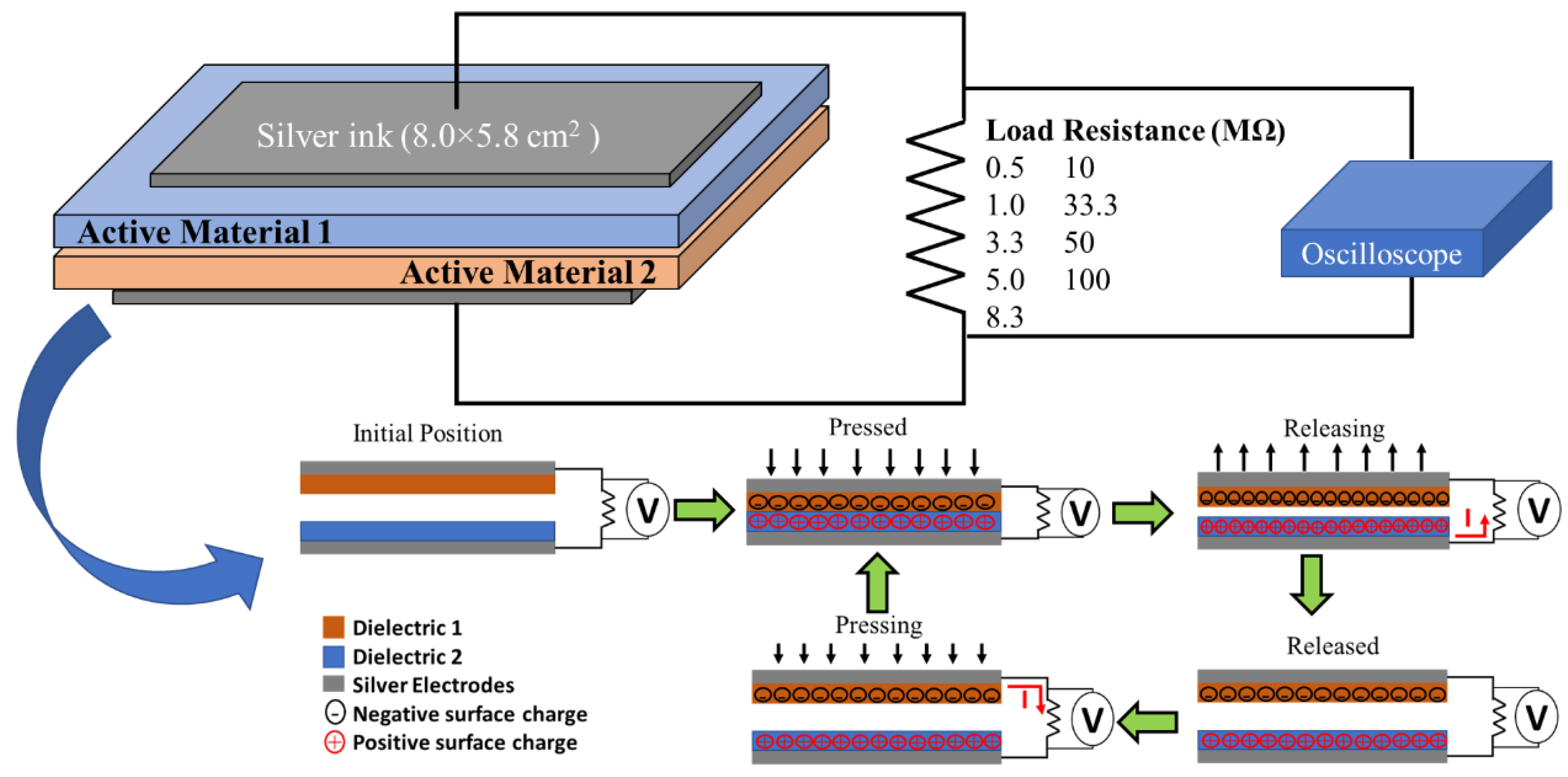

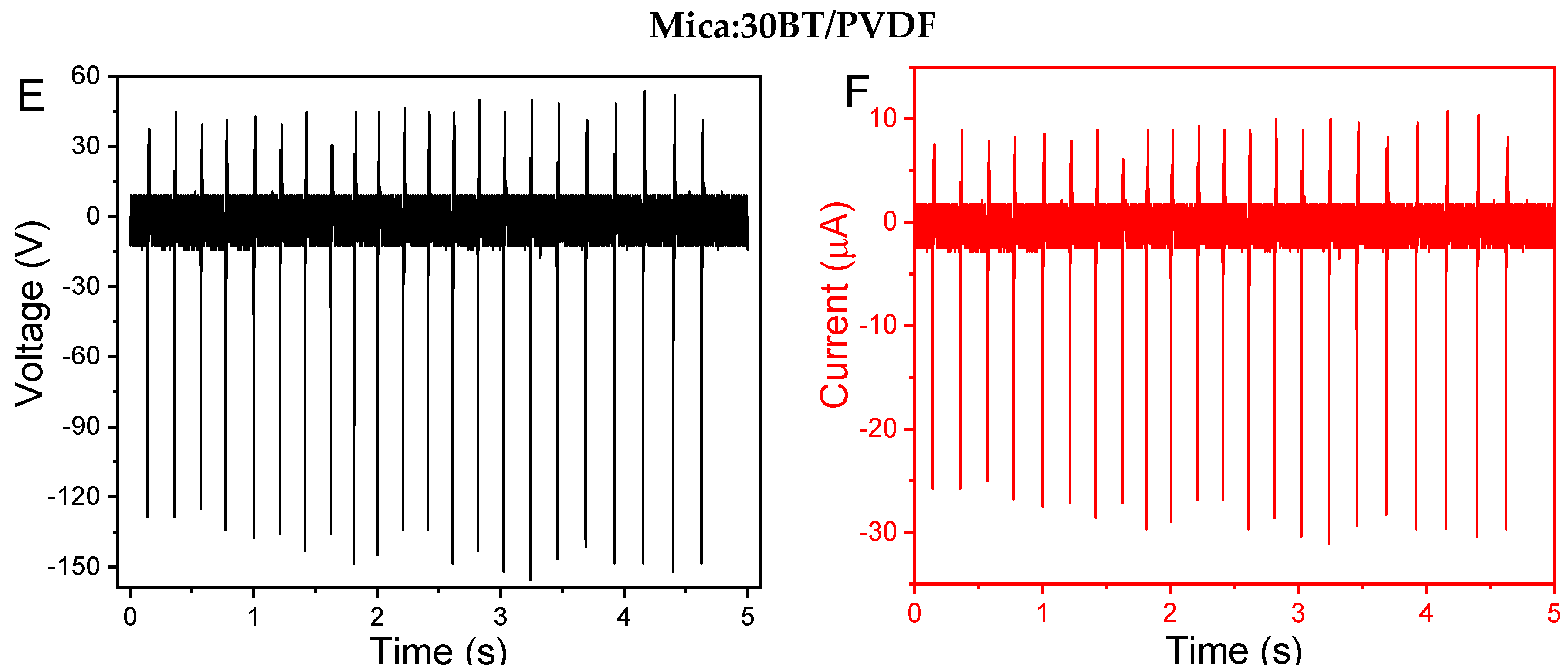
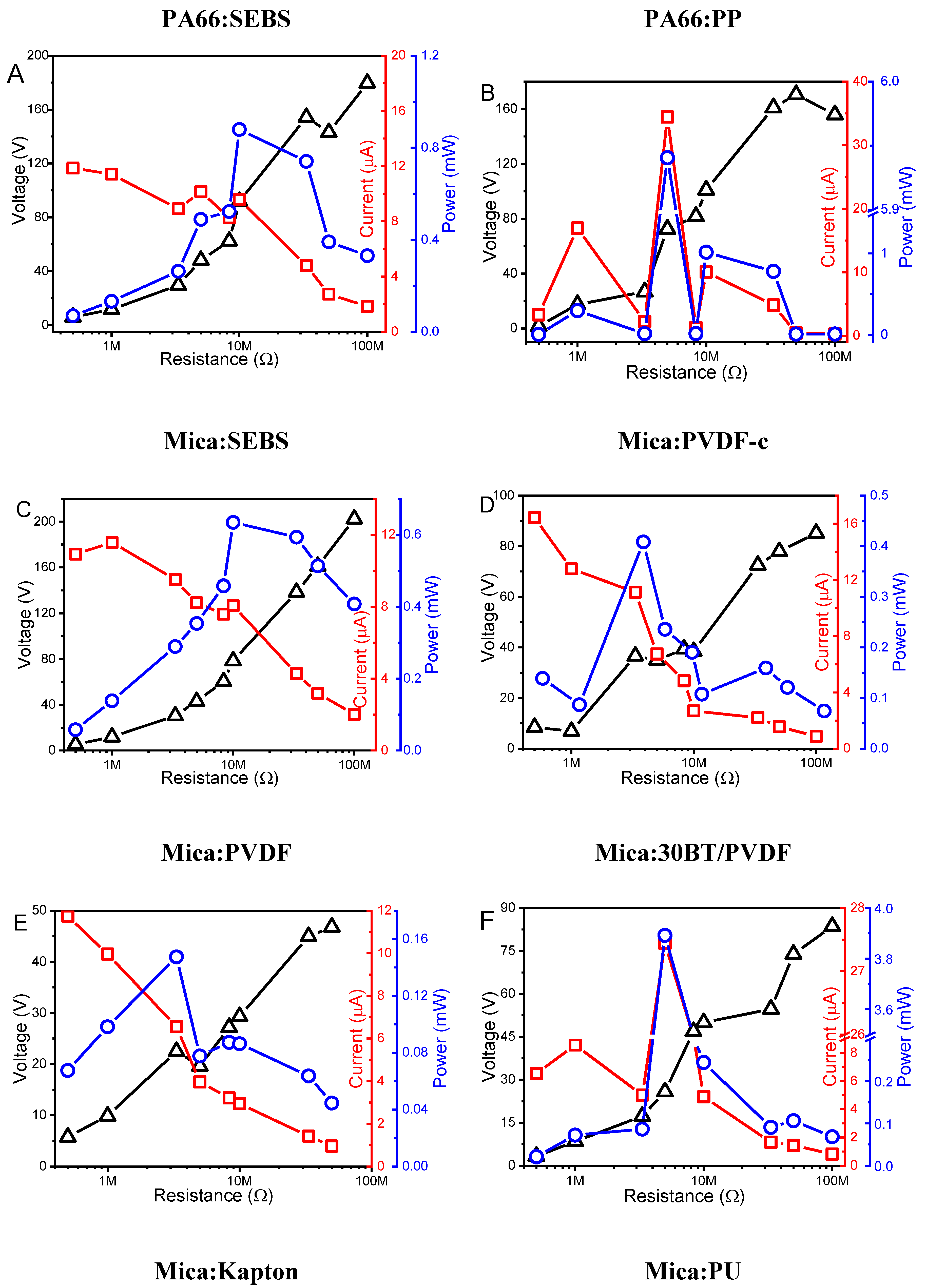
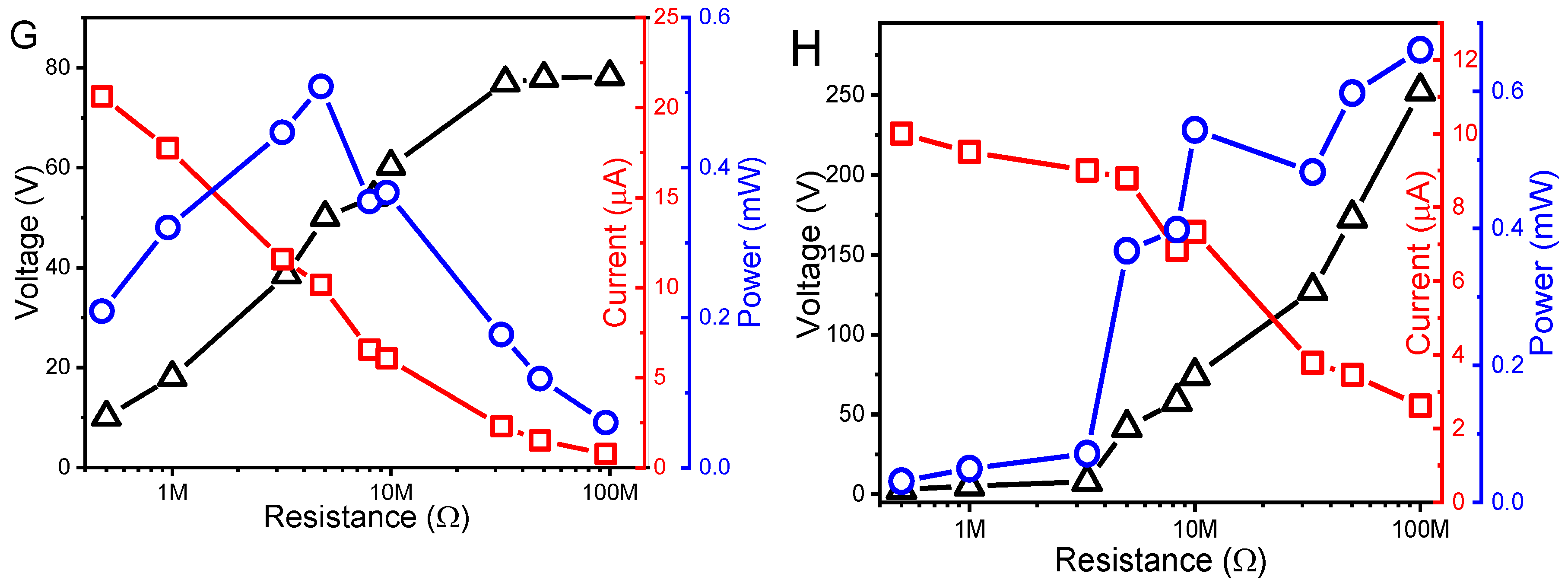
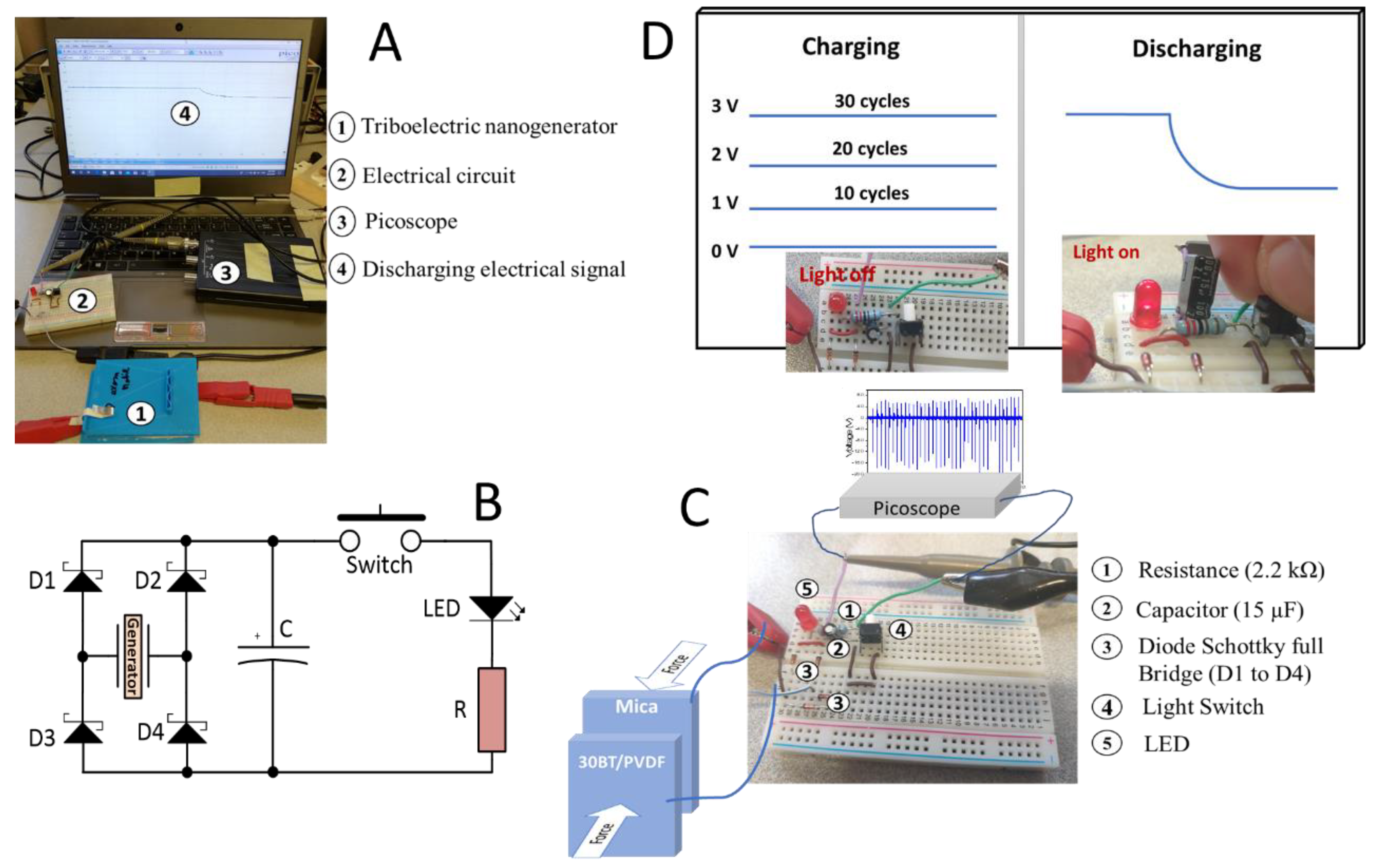
| (A) | |||
| Positive | Negative | ||
 | Mica polyamide 6-6 (PA66) styrene-ethylene/butylene-styrene (SEBS) | polyvinylidene fluoride (PVDF) polyurethane (PU) polypropylene (PP) polyimide (Kapton) |  |
| (B) | |||
| Mica | PVDF polyvinylidene fluoride commercial (PVDF-c) 30 wt.% barium titanate/polyvinylidene fluoride (30BT/PVDF) Kapton PU SEBS | ||
| PA66 | SEBS PP | ||
| Materials | RL (MΩ) | Voltage (V) | Current (µA) | Power (mW) |
|---|---|---|---|---|
| PA66:PP | 5 | 172.5 | 34.4 | 5.9 |
| PA66:SEBS | 5 | 68.1 | 13.2 | 0.9 |
| Mica:SEBS | 10 | 78.6 | 8.1 | 0.6 |
| Mica:PVDF-c | 3.3 | 36.7 | 11.1 | 0.4 |
| Mica:PVDF | 3.3 | 22.5 | 6.6 | 0.2 |
| Mica:30BT/PVDF | 5 | 141.8 | 27.4 | 3.9 |
| Mica:Kapton | 5 | 50.1 | 10.2 | 0.5 |
| Mica:PU | >100 | 252.4 | 2.6 | 0.7 |
Publisher’s Note: MDPI stays neutral with regard to jurisdictional claims in published maps and institutional affiliations. |
© 2020 by the authors. Licensee MDPI, Basel, Switzerland. This article is an open access article distributed under the terms and conditions of the Creative Commons Attribution (CC BY) license (http://creativecommons.org/licenses/by/4.0/).
Share and Cite
Rodrigues-Marinho, T.; Castro, N.; Correia, V.; Costa, P.; Lanceros-Méndez, S. Triboelectric Energy Harvesting Response of Different Polymer-Based Materials. Materials 2020, 13, 4980. https://doi.org/10.3390/ma13214980
Rodrigues-Marinho T, Castro N, Correia V, Costa P, Lanceros-Méndez S. Triboelectric Energy Harvesting Response of Different Polymer-Based Materials. Materials. 2020; 13(21):4980. https://doi.org/10.3390/ma13214980
Chicago/Turabian StyleRodrigues-Marinho, Tiago, Nelson Castro, Vitor Correia, Pedro Costa, and Senentxu Lanceros-Méndez. 2020. "Triboelectric Energy Harvesting Response of Different Polymer-Based Materials" Materials 13, no. 21: 4980. https://doi.org/10.3390/ma13214980
APA StyleRodrigues-Marinho, T., Castro, N., Correia, V., Costa, P., & Lanceros-Méndez, S. (2020). Triboelectric Energy Harvesting Response of Different Polymer-Based Materials. Materials, 13(21), 4980. https://doi.org/10.3390/ma13214980







